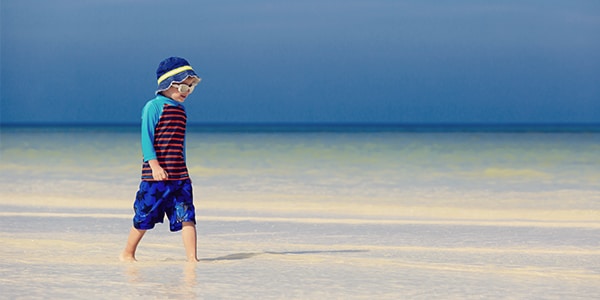5 sun safety myths
Before heading outdoors this summer, brush up on your 'slip, slop, slap, seek and slide’ knowledge.
Despite our country being famous for sunshine, Australians are misinformed about sunscreen use, according to research by Cancer Council Australia.
Australians have one of the highest incidents of skin cancer in the world, two to three times the rates in Canada, the US and the UK. “Sunscreen has been proven to prevent skin cancer, including the most deadly type – melanoma,” says Craig Sinclair, chair of the Public Health Committee, Cancer Council Australia. It’s time to bust these myths and get the right information about sun protection.”
Here are five common myths about sun protection and UV exposure:

Myth 1: Water-resistant sunscreen won't come off
“It's important to remember that water-resistant sunscreen is tested in a lab, not in real-world conditions,” says Heather Walker, chair of the Skin Cancer Committee at Cancer Council Australia.
“The product may say that it's four hours water-resistant, but you should reapply it every two hours as you're running around, swimming, sweating and towel drying.”
Sunscreen shouldn’t be used as the only defence against sun damage. Heather recommends using “SPF30 or higher, which protects against UVA and UVB rays, as well as following the slip (on a shirt), slop (on sunscreen), slap (on a hat), seek (shade) and slide (on sunglasses) rule.”
Myth 2: A small amount of sunscreen provides protection
According to Cancer Council Australia, four out of five Australians don’t apply enough sunscreen. Craig recommends applying sunscreen 20 minutes before heading outdoors, reapplying every two hours and using the recommended amount: one teaspoon for every limb, front of the body, back and head if you want to lower your risk of developing skin cancer.
Myth 3: Sunscreen will stop you absorbing vitamin D
“In summer most of us get enough vitamin D through incidental sun exposure – excess sun exposure, even for those with vitamin D deficiency, is never recommended,” says Craig. Sensible sun protection shouldn’t put you at risk of vitamin D deficiency so think about protecting your skin.
Myth 4: You won't damage your skin if you're under an umbrella
“You can get sunburn under an umbrella as UV reflects off different surfaces,” says Heather.
“Shade is one of the five forms of sun protection, so you still need to wear sunscreen, reapply it every couple of hours and wear a hat, sunglasses and protective clothing for exposed parts of your body.”
Myth 5: If you have dark skin, you don't need to wear sunscreen
“Fairer-skinned people are most at risk of sunburn,” says Heather. “However, everyone in Australia is at risk because of the high UV levels. This is why we should all wear an SPF30 or higher sunscreen when the UV Index is 3 or above.
“Darker skin has a lower risk of sunburn and skin cancers. However, some research has found that skin cancers in darker-skinned people are found at a later stage, when they’re harder to treat.”
What's your skin type?
The Fitzpatrick rule provides a general categorisation of skin types. Types 1 and 2 have the highest risk of skin cancer, while types 4 and 5 have the lowest.
Updated October 2021.
Related articles
WHY you NEED TO BE SUN SMART
Australia has some of the highest UV radiation levels in the world, increasing our skin cancer risk.
WHY YOU SHOULD DO A SKIN CANCER CHECK TODAY
Here’s how to keep an eye on your skin and lower your risk.
HOW TO EXERCISE SAFELY IN THE HEAT
We find out how to work out safely during the warmer months.
SUMMER FRUIT COBBLER
This vitamin C-packed mix of stone fruit and berries will have you coming back for seconds.